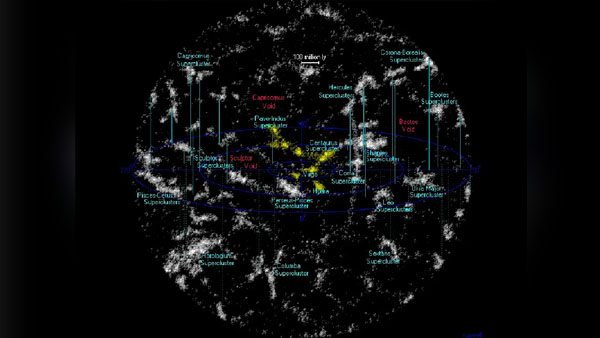By Satyabrat Borah
Scientists have long turned to the mysteries of black holes to unlock secrets about our place in the vast expanse of the universe. These enigmatic cosmic entities, where gravity is so intense that not even light can escape, serve as crucial beacons for understanding the structure, expansion, and evolution of the cosmos. By studying the signals emitted from around black holes, particularly radio waves, astronomers can map out galaxies, trace the history of the universe back to the Big Bang, and pinpoint our exact location within this immense framework. It’s like using distant lighthouses to navigate a foggy sea. However, in an ironic twist, the very technology that connects us in our daily lives like mobile phones and WiFi is increasingly obscuring this cosmic view, creating interference that hampers scientific progress.
To appreciate the issue, we first need to delve into why black holes are so vital to astronomy. Black holes form from the collapse of massive stars, creating regions of spacetime so warped that they devour everything nearby. But it’s not just their destructive power that fascinates scientists; it’s the phenomena around them. For instance, as matter spirals into a black hole, it heats up and emits powerful radiation across the electromagnetic spectrum, including radio waves. These waves travel across billions of light-years to reach us, carrying information about the black hole’s environment, the distribution of dark matter, and even the rate at which the universe is expanding. Projects like the Event Horizon Telescope, which captured the first image of a black hole in 2019, rely on synchronizing radio telescopes around the world to create a virtual Earth-sized observatory. This allows us to “see” these invisible giants and, by extension, orient ourselves in the cosmic landscape.
Our position in the universe isn’t just a philosophical question.It’s a scientific one with profound implications. By analyzing black holes in distant galaxies, astronomers can measure redshift, which tells us how fast objects are moving away from us due to the universe’s expansion. This helps refine the Hubble constant, a key parameter in cosmology. Moreover, supermassive black holes at the centers of galaxies act as anchors, influencing galactic formation and evolution. Understanding them helps us comprehend why our Milky Way looks the way it does and where Earth fits into this galactic neighborhood. Without clear observations, we’re essentially flying blind in our quest to answer fundamental questions: How did the universe begin? Where is it headed? And what is our role in it?
Yet, this pursuit is being thwarted by an unlikely culprit: the radio frequency interference (RFI) from everyday devices. Mobile phones, WiFi routers, satellite communications, and even Bluetooth gadgets operate on frequencies that overlap with those used in radio astronomy. Radio telescopes are incredibly sensitive instruments designed to detect faint signals from the edge of the observable universe. When a telescope picks up these human-made signals, it drowns out the cosmic whispers, leading to noisy data that’s hard to interpret. Imagine trying to listen to a faint whisper in a crowded stadium; that’s the challenge astronomers face today.
The problem has escalated with the rollout of modern technologies. The advent of 5G networks, for example, uses higher frequency bands that encroach on the spectrum reserved for astronomical observations. WiFi 6 and beyond promise faster internet but at the cost of more pervasive RFI. Even low-Earth orbit satellites like those in Starlink constellations beam down signals that can blanket the sky, creating streaks of interference in telescope data. In remote observatories, where scientists once escaped urban noise, this satellite pollution is becoming unavoidable. A study published in Nature Astronomy in 2023 highlighted how satellite mega-constellations could increase RFI by up to 10 times, potentially blinding radio telescopes to certain frequencies.
This interference isn’t just a minor annoyance; it has real consequences for science. Take the search for fast radio bursts (FRBs), mysterious millisecond-long pulses often linked to black holes or neutron stars. Detecting these requires pristine radio data, but RFI can mimic or mask them, leading to false positives or missed discoveries. Similarly, efforts to study the cosmic microwave background rely on mapping subtle temperature variations, which RFI can distort. If we can’t observe black holes accurately, our models of the universe become less reliable, stalling advancements in physics, from general relativity to quantum gravity theories.
The human element adds another layer to this dilemma. Our reliance on connectivity has exploded; billions of people use smartphones daily for work, social interaction, and entertainment. WiFi is ubiquitous in homes, offices, and public spaces, enabling everything from streaming videos to smart home devices. This technological boom has lifted societies, bridging gaps and fostering innovation. But it comes at a price. As urban sprawl and digital infrastructure expand, even protected “radio quiet zones” like the National Radio Quiet Zone in West Virginia, USA, face encroachments from nearby developments.
Astronomers are fighting back with creative solutions. One approach is relocating telescopes to isolated spots with minimal human activity. The Atacama Desert in Chile hosts the Atacama Large Millimeter/submillimeter Array (ALMA), perched at high altitudes where the dry air and remoteness reduce interference. Similarly, the Square Kilometre Array (SKA), an ambitious project spanning Australia and South Africa, is being built in radio-quiet regions to capture unprecedented details of black holes and early universe phenomena. These sites enforce strict controls: no cell phones, no WiFi, and even restrictions on vehicle electronics.
Technological fixes are also emerging. Advanced signal processing algorithms can filter out RFI, using machine learning to distinguish cosmic signals from terrestrial noise. For instance, software like RFI mitigation tools in the MeerKAT telescope in South Africa employs real-time excision of interfering signals. International regulations play a role too. The International Telecommunication Union (ITU) allocates spectrum bands for astronomy, designating “protected” frequencies where commercial use is limited. However, enforcement is tricky, as demand for bandwidth from telecom giants grows. Advocacy groups like the Committee on Radio Astronomy Frequencies (CRAF) lobby for better protections, urging governments to balance economic interests with scientific needs.
Collaboration between scientists and industry offers hope. Some companies are designing “astronomy-friendly” technologies, like satellites that dim their signals over observatories or WiFi systems that avoid sensitive bands. Public awareness is key; educating people about the invisible pollution of RFI could lead to supportive policies. Imagine apps that notify users when their devices might interfere with nearby telescopes, encouraging temporary shutdowns.
This conflict highlights a broader tension in human progress: the trade-off between immediate convenience and long-term knowledge. Black holes remind us of our smallness in the universe, yet our gadgets are inadvertently veiling that truth. To truly know where we are, we must quiet the digital clamor. By fostering dialogue between tech developers, policymakers, and astronomers, we can preserve the clarity needed to gaze into the abyss.
Black holes aren’t just distant curiosities.They’re mirrors reflecting our cosmic address. If we let phones and WiFi block the view, we risk losing sight of our place in the grand scheme. But with mindful innovation, we can have our connectivity and our cosmos too. The universe is calling; we just need to clear the line.




